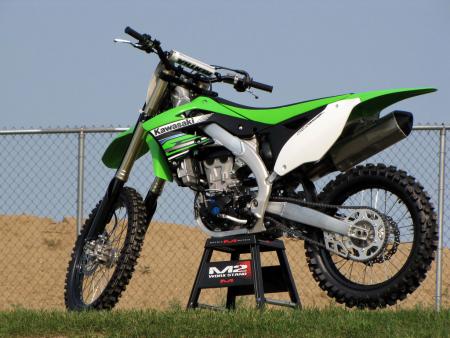 |
| Top 2013 Kawasaki KX450F Review - First Impressions |
KX450F from winning popularity contests. After we rode the 2011 version on everything from frozen lakes to motocross to cross-country to flat track, we pretty much had the bike figured out. When we learned about the changes Kawasaki made to the KX450F for 2012, we couldn’t wait to try it at its press launch at the famous Red Bud track in Buchanan, MI.
Everything you’ve always wanted in a KX450F. And less. |
Kawasaki is proud of the improvements it made to the 2012 KX450F. We’ll run through a quick recap, but you can read about those changes in greater detail here.
KX450Fs have won everywhere, from the Supercross tracks to the desert. We expect that streak to continue in 2012. |
Kawasaki addressed the too big complaints in a variety of ways. First, there's a new, slimmer frame, but more importantly the handlebars can be adjusted to four different settings thanks to new triple clamps, while footpegs can be raised or lowered to fit your personal preference. If the KX450F still feels a little big, there's an optional suspension linkage that drops seat height 6mm. The end result is the most ergonomically adjustable motocross bike in recent memory.
Kawasaki also worked to improve reliability by including a thicker first gear, a revised crankshaft designed to improve low-end throttle response and engine balance, and thinner piston rings to improve throttle response. They cut small bits of weight all over the bike, going so far as to install a lighter fuel pump. A revised fuel injection system makes EFI tuning easier than ever. A new exhaust system was designed to cut weight, boost performance and still meet AMA sound regulations. Something totally new is the Kawasaki Launch Control System. It is designed to improve traction and rideability off the starting line before it kicks back into ‘normal’ mode when the rider selects third gear.
Plug and play. Swapping between the three basic fuel injection maps takes only a few seconds. |
Red Bud is an amazing motocross facility, with nicely groomed grounds and a world-class motocross track. Obviously you can’t do a ‘real world’ motorcycle test on one perfectly groomed national-level motocross track with factory technicians looking over your shoulders. We tried to find varied riding conditions in addition to the motocross track, but this is more of a ‘first impression’ report than a proper motorcycle test. Our first impression, after having spent so much time on 2011 and 2010 KX450Fs, was how the 2012 model felt much smaller and lighter than its predecessors.
One thing that helped cornering and overall rideability on the 2011 KX450F was to recalibrate the milder fuel injection mapping at the bottom end of the powerband. Fuel-injection tuning on previous KX450Fs was complicated, requiring special programs and adaptors. On the 2012 model swapping between three basic EFI maps takes 10 seconds with no special tools. Kawasaki has three color-coded EFI plugs, soft terrain, intermediate-normal, and hard terrain that simply click into the wiring harness. The hard terrain map is designed for low-traction conditions, so it’s actually the ‘softest’ powerband of the three. At first we were embarrassed to admit we preferred the softer-hit of the ‘hard pack/no traction’ map, but found out later that most of the other magazine editors liked the gentler map better too.
Ergonomic upgrades help make the 2012 KX450F feel noticeably lighter than its predecessors. |
Even brand new, with zero-time on the clock, the 2012 KX450F shifted nicely under power and the clutch worked well. We did notice a sizable gap between second and third gear ratios that was a little too big. Adding a tooth or two to the rear sprocket would be an improvement. The light and progressive clutch feel really helps the manners of the KX450F, but how long that clutch will last remains to be seen. Kawasaki has upgraded the 2012 to use slightly stiffer clutch springs to cure the well-publicized premature wear problem they had with older models. In the two days we rode the 2012 the clutch never faded or needed excessive adjustment. First gear is even low enough for off-road use, especially considering there is so much torque on tap.
Light and precise clutch action make the KX450F surprisingly easy to ride in low-traction situations. |
It was a blistering 97F on day-two. When we were going slow and pretending to be Endurocrossers, we cooled off the KX450F by splashing through some water, but we didn’t need to. The radiators gurgled a little in slow running but never boiled out their coolant. That’s another improvement over the 2010 and 2011 models. Sometimes when the engine got really hot it would flame out at low rpm and take several kicks to restart. That’s something we never had a problem with last year and could likely be cured with careful EFI tuning. Aside from the three basic ‘plug and play’ maps the new Kawasaki fuel injection system is infinitely variable through a normal Windows PC.
Despite some major changes to the chassis, vague cornering remains as one of the KX450F's traits. This is a big, powerful motorcycle that likes to be steered with the throttle. When ridden aggressively it will power around turns quickly, but it won’t rule the inside line. The 2012 KX450F will turn sharply, but you have to work at it and the bike does wander more than we’d like.
The KX-F likes slam dancing, not ballet. It likes to turn with a fist full of throttle and the rear wheel spinning. |
We tried to improve cornering by adjusting fork height, fork rebound and compression settings, rear suspension sag and high-speed compression and handlebar positioning to find the ideal balance between traction, stability and turning ability. Cornering improved but was never great. That being said, the big Kawasaki is exceptionally stable at speed. The rear brake on the KX450F is excellent but the front remains average. We bled the front brake and tried different lever adjustments but never got rid of the touchy ‘on or off’ feel. Different pads or a different rotor might help. We’d like to try a different front tire as well, which could potentially improve both cornering and braking performance.
The suspension soaks up hard landings without a whimper, even when pushed to the stops. Small bump performance is another matter, as the bike hops around too much and transmits too much track hack to the rider. |
The 2012 KX450Fs suspension did beat us up over smaller square-edged impacts on the track. It was difficult to get the shock preload backed off enough to get 95-100mm of sag with a 160-pound rider. Heavier riders didn’t complain as much, but it’d be nice if Kawasaki equipped the 450 with the SFF preload-adjustable forks it uses on the 250F. Kawasaki changed the shock linkage this year to improve rear wheel traction. Careful chassis set-up was essential, and when we backed off the compression to absorb chop the bike became more difficult to jump. Bottoming resistance was always excellent, and even when the suspension bottomed out the impact was never overly harsh.

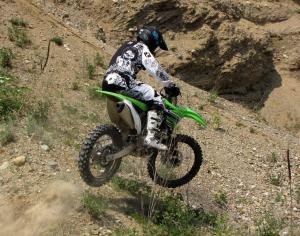
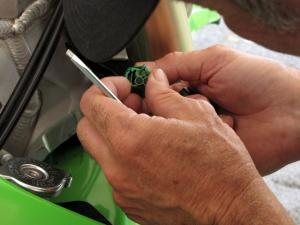
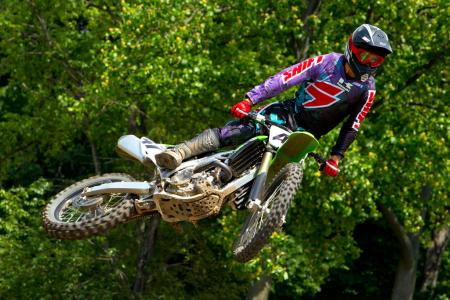
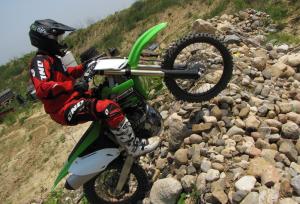
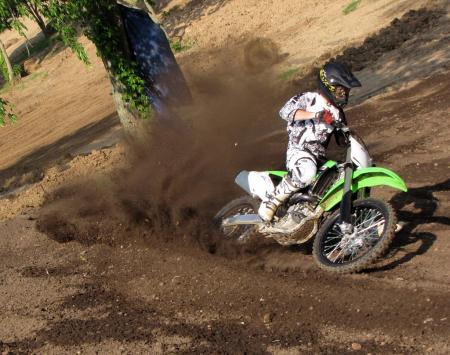
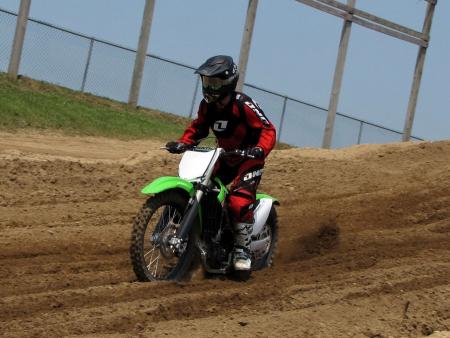
No comments:
Post a Comment